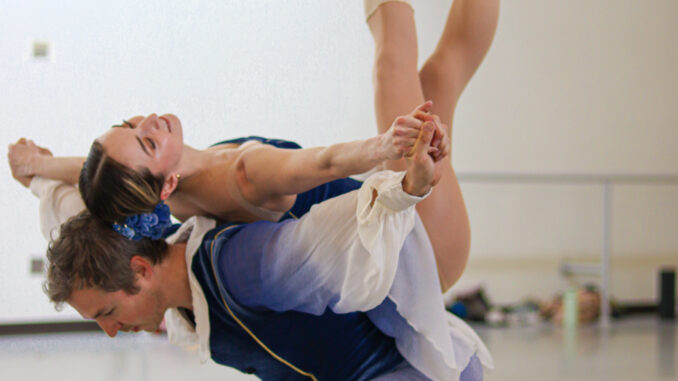
Naomi Girson | Staff Writer
The dancers took their places as the curtain rose, while the music started to hum from the live orchestra. As they leapt across the stage like skillful acrobats, the dancers pushed themselves to their limits with their flexibility and body control. Each of the scenes and musical pieces carried them with impeccable rhythm and synchronicity.
The Pittsburgh Ballet Theatre (PBT) is leaping into the spring season with their “Spring Mix,” featuring four movements tying contemporary and neoclassicism together in one bright performance. Using a mixture of choreographers, including award-winning Pittsburgh-based Jae Man Joo, they put together a perfect seasonal show.
With only four performances set to hit the stage at the Benedum Center from April 5 to 7, all are encouraged to revel in the ballet. In preparation for the show’s premiere, PBT invited The Duke to a media preview earlier last week.
Each piece is wildly different from the last, but they all mesh together to create the same feelings of new beginnings and spring awakening. There is more than one cast for each movement due to the rigorous nature of the work they are doing.
The dancing, especially when it is as explosive as in the “Spring Mix,” is extremely hard on all of the dancers and their bodies.
They work each day to make sure they maintain their body to be able to continue pushing themselves to the limit.
‘Allegro Brillante,’ a neo classical piece from the “father of 20th-century American ballet” George Balanchine, is used in juxtaposition with more contemporary pieces, lending to the company’s emphasis on their double world debuts.
“Mr. Balanchine choreographed over 400 works [that] many ballet companies [have] nationally performed,” said Director of PBT and curator of the Spring Mix Adam McKinney.
Balanchine said the allegro in PBT’s “Spring Mix” “contains everything I know about the classical ballet in 13 minutes.”
This movement featured 10 dancers in more traditional tulle costumes in lighter pastels.
The dancing was dynamic, fun and light while featuring harmonies with the whole cast. Each dancer had their moment to shine, as they worked hard to hit all of Balanchine’s intricate and specific movements.
During Choreographer-in-Residence Yoshiaki Nokano’s ‘Violin Pas de Deux,’ the stage filled with two instead of 10 for an eye-catching performance.
The duo moved across the stage so in time with the music, it was as if they were composing through their dancing. The duet was danced by William Moore and Jessica McCann.
As the two went through the movement, the focus behind their eyes was evident but graceful. The dance featured lots of lifts and seamless movements, entangling the two into the music, the movement and each other.
“The orchestra makes everything better,” “Spring Mix” dancer Diane Yohe said.
Returning to PBT, and perhaps most contemporary of the mix, was Helen Pickett’s ‘Petal.’ These movements were more explosive, with eight dancers performing, four men and four women.
The ‘Petal’ cast were adorned in vibrant bright blues and yellows, tying in with the bright music and dynamic ideas spread throughout the piece.
‘Petal’ was extremely expressive, with large, exaggerated movements that used the whole body to convey a myriad of emotions from intimacy to joy.
‘When Time Stands Still’ will also make its world debut at the “Spring Mix.”
The movement is choreographed by Jae Man Joo, assistant professor at Point Park University and 2009 Princess Grace Award for Excellence in Choreography.
This piece will be officially unveiled during their first performance on opening night.
The piece is set to be “a riveting contemporary piece with an energetic pace that highlights the artists’ athleticism with crisp, graceful movements and provides an intriguing contrast between elegance and energy,” according to a news release.
In a special offer for students, PBT offers a discount code available for use when buying tickets on their website at www.pbt.org. Tickets start at $29 before using discount code “PBTSTUDENT.”
Several ‘Q&A’ sessions will be available to the public through PBT’s Education and Community Engagement programs, with choreographers Helen Pickett, répétiteur Zippora Karz and director McKinney sharing their knowledge and expertise with audience members after the shows.
Registration is not required for the sessions and they will take place in the Orchestra level.
Ballet is not always at the forefront for most audiences, but as it evolves into the contemporary space – while still respecting its historical and neo classical roots – the discipline continues to evolve and inspire new viewers.
McKinney believes that watching the “Spring Mix” will show off the art and its rigorous athleticism and dedication.
“I want [people] to take away not only being excited about PBT and the direction of PBT but notice how hard people work,” McKinney said. “I want people to feel at home when they come to [the show].”

